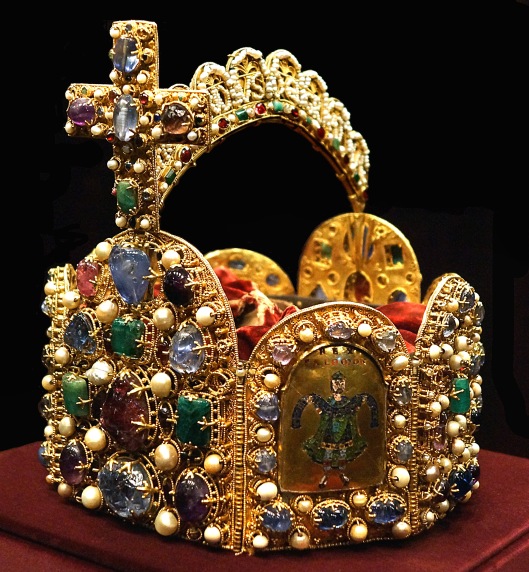Tags
Byzantine Empire, Charlemagne, Charles the Great, coronation, Emperor Constantine VI, Emperor of the Romans, Empress Irene, King of the Franks, Paderborn
In 799, Pope Leo III did not have a good relationship with the citizens of Rome
Prompted by jealousy, ambition, or the thought that only someone of the nobility should hold the office of pope, a number of relatives of Adrian I formed a plot to render Pope Leo III unfit to hold his office. Pope Adrian I who died in 795, was the son of Theodore, a Roman nobleman.
On the occasion of the procession of the Greater Litanies, April 25, 799, when the pope was making his way towards the Flaminian Gate, he was suddenly attacked by armed men.
He was dashed to the ground, and an effort was made to root out his tongue and tear out his eyes which left him injured and unconscious. He was rescued by two of Charlemagne’s missi dominici, who came with a considerable force.
Pope Leo III, naturally fearing for his life, was sheltered by Duke Winiges of Spoleto. Pope Leo III later to Paderborn and the court of King Charles the Great of the Franks. Charles the Great is more commonly known as Charlemagne.
At Paderborn, Charlemagne’s camp, Pope Leo III was received by the Frankish king with the greatest honour. This meeting forms the basis of the epic poem Karolus Magnus et Leo Papa.
Pope Leo III was accused by his enemies of adultery and perjury. Charlemagne ordered them to Paderborn, but no decision could be made. He then had Pope Leo III escorted back to Rome. In November 800, Charlemagne himself went to Rome, and on December 1 held a council there with representatives of both sides.
Pope Leo III, on December 23, took an oath of purgation concerning the charges brought against him, and his opponents were exiled.
Coronation of Charlemagne
Two days after his oath, on Christmas Day 800, Charlemagne knelt at the altar to pray, Pope Leo III crowned him Imperator Romanorum (“Emperor of the Romans”) in Saint Peter’s Basilica. By doing this the Pope effectively restarted the Roman Empire in Western Europe and nullified the legitimacy of Empress Irene of Constantinople.
According to Charlemagne’s biographer, Einhard, Charlemagne had no suspicion of what was about to happen, and if informed would not have accepted the imperial crown. There is, however, no reason to doubt that for some time previous the elevation of Charlemagne had been discussed, both at home and at Rome, especially since the imperial throne in Constantinople was controversially occupied by a woman, Irene of Athens, and since the Carolingian dynasty had firmly established its power and prestige.
The coronation offended and was not approved by most people in Constantinople, which had seen itself still as the rightful defender of Rome, but Empress Irene, like many of her predecessors since Justinian I, was too weak to offer protection to the city or its much reduced citizenry.
The Byzantines, occupied with their own defenses, were in no position to offer much opposition to it.
It was seen by scholars of the day that when Odoacer forced the abdication of Roman Emperor Romulus Augustulus in 476CE this did not effectively abolish the Western Roman Empire as a separate power in Europe.
Theoretically the powers of the Western Roman Emperor were said to have been reunited with, or grafted into, the Eastern Roman Empire. Therefore from that time contemporary scholars believed that there was a singular undivided Roman Empire. Pope Leo III and King Charlemagne, as well as their predecessors, also held to this political ideal of there being a singular Roman Empire that was one and indivisible.
However, the imperial coronation of Charlemagne was not believed to have caused a severance of the Roman Empire back into East and West factions. In the eyes Leo III and Charlemagne, along with contemporary political theorists, they were not revolting against a reigning sovereign, Empress Irene, but legitimately filling up the void of legitimate successors caused by the deposition Emperor Constantine VI in 797 and Charlemagne was held to be the legitimate successor, not of the Emperor Romulus Augustulus, but that of Emperor Constantine VI.
The reality was that his imperial coronation had the effect of setting up two separate, and often opposing, Empires along with two separate claims to imperial authority.
One of the issues that has been debated by scholars is whether or not Charlemagne saw this prestigious gift bestowed on him on that Christmas Day? According to the twenty-eight chapter of Einhard’s Vita Karoli Magni which says that Charlemagne was ignorant of the Pope’s intent and did not want any such coronation:
“He (Charlemagne) at first had such an aversion to being granted the imperial title that he declared that he would not have set foot in the Church the day that theses imperial titles were conferred, although it was a great feast-day, if he could have foreseen the design of the Pope.”
A number of modern scholars, however, logically suggest that Charlemagne was indeed aware of the coronation. It has been said he certainly could not have missed the bejewelled crown waiting on the altar when he came to pray; something even contemporary sources support.
Charlemagne is counted as Charles I, Holy Roman Emperor, but many scholars believe the state that evolved into the Holy Roman Empire of the German Nation instead began with the coronation of Otto I, King of West Francia and Duke of Saxony in 962. Otto I was crowned Emperor by Pope John XII at Olds St. Peter’s Basilica.













